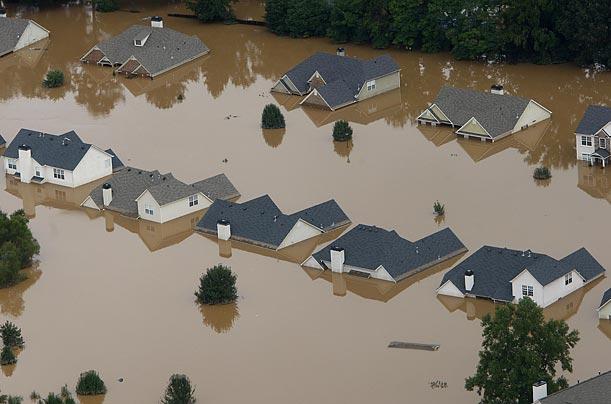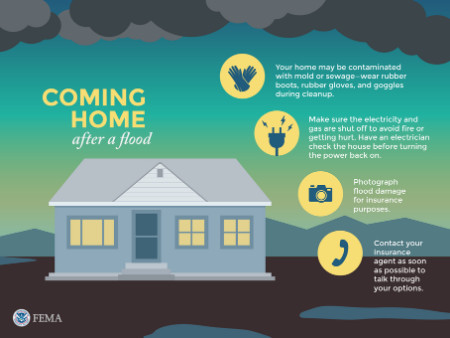 When the Clouds Form
When the Clouds Form
From Clatsop County, OR Emergency Management
Flood waters can be extremely dangerous. The force of six inches of swiftly moving water can knock people off their feet. The best protection during a flood is to leave the area and go to shelter on higher ground.
Floods are the most common and widespread of all natural disasters – except fire. Most communities in the United States can experience some kind of flooding after spring rains, heavy thunderstorms, or winter snow thaws. Floods can be slow, or fast rising but generally develop over a period of days.
What can you do?
Nobody can stop a flood. But if you are faced with one, there are actions you can take to protect your family and minimize your property losses.
Mitigation helps! It lessens the damaging effects from flooding. Participating in the National Flood Insurance Program (NFIP) and enforcing sound floodplain management techniques are steps your community can undertake. Constructing barriers such as levees will also help reduce the amount of damage to your home and crops, while purchasing flood insurance reduces the financial burden should a flood or flash flood occur.
The most important thing is to make sure your family is safe.
KNOW THESE TERMS
- Flood Watch: Flooding is possible. Tune in to NOAA Weather Radio, commercial radio, or television for information.
- Flash Flood Watch: Flash flooding is possible. Be prepared to move to higher ground; listen to NOAA Weather Radio, commercial radio, or television for information.
- Flood Warning: Flooding is occurring or will occur soon; if advised to evacuate, do so immediately.
- Flash Flood Warning: A flash flood is occurring; seek higher ground on foot immediately.
Before a Flood
To prepare for a flood, you should:
- Avoid building in a floodplain unless you elevate and reinforce your home.
- Elevate the furnace, water heater, and electric panel if susceptible to flooding.
- Install "check valves" in sewer traps to prevent floodwater from backing up into the drains of your home.
- Construct barriers (levees, beams, floodwalls) to stop floodwater from entering the building.
- Seal walls in basements with waterproofing compounds to avoid seepage.
If you live in a frequently flooded area, take preventative measures and stockpile emergency building materials:
- Plywood, plastic sheeting, lumber, nails, hammer and saw, pry bar, shovels, and sandbags.
- Have check valves installed in building sewer traps to prevent flood waters from backing up in sewer drains.
- As a last resort, use large corks or stoppers to plug showers, tubs, or basins.
Plan and practice an evacuation route
- Learn flood-warning signs and your community's alert signals
- Develop an emergency communication plan.
- In case family members are separated from one another during floods or flashfloods, have a plan for getting back together.
- Ask an out-of-state relative or friend to serve as the "family contact." After a disaster, it's often easier to call long distance. Make sure everyone in the family knows the name, address, and phone number of the contact person.
Make sure that all family members know how to respond after a flood or flash flood
- Teach all family members how and when to turn off gas, electricity, and water.
- Teach children how and when to call 9-1-1, police, fire department, and which radio station to tune to for emergency information.
- Be prepared to evacuate.
If a flood is likely in your area, you should:
- Listen to the radio or television for information.
- Be aware that flash flooding can occur. If there is any possibility of a flash flood, move immediately to higher ground. Do not wait for instructions to move.
- Be aware of streams, drainage channels, canyons, and other areas known to flood suddenly. Flash floods can occur in these areas with or without such typical warnings as rain clouds or heavy rain.
If time permits, here are other steps you can take before the floodwaters come:
- Turn off all utilities at the main power switch and close the main gas valve if evacuation appears necessary. Disconnect electrical appliances. Do not touch electrical equipment if you are wet or standing in water
- Move valuables, such as papers, furs, jewelry, and clothing to upper floors or higher elevations.
- Fill bathtubs, sinks and plastic soda bottles with clean water. Sanitize the sinks and tubs first by using bleach. Rinse, then fill with clean water.
- Bring outdoor possessions, such as lawn furniture, grills and trash cans inside, or tie them down securely.
Once the Flood Arrives
If you have to leave your home, remember these evacuation tips:
- Do not walk through moving water. Six inches of moving water can make you fall. If you have to walk in water, walk where the water is not moving. Use a stick to check the firmness of the ground in front of you.
- Do not drive into flooded areas. If you come upon a flooded road, turn around and go another way. More people drown in their cars than anywhere else. Six inches of water will reach the bottom of most passenger cars causing loss of control and possible stalling. A foot of water will float many vehicles. Two feet of rushing water can carry away most vehicles, including sport utility vehicles (SUV’s) and pick-ups.
- If floodwaters rise around your car, abandon the car and move to higher ground if you can do so safely. You and the vehicle can be quickly swept away.
- If your car stalls, abandon it immediately and climb to higher ground. Many deaths have resulted from attempts to move stalled vehicles.
- Don't walk through flooded areas. As little as six inches of moving water can knock you off your feet.
- Stay away from downed power fines and electrical wires. Electrocution is another major source of deaths in floods. Electric current passes easily through water.
- Look out for animals – especially snakes. Animals lose their homes in floods, too. They may seek shelter in yours.
- Take dry clothing, a flashlight and a portable radio with you. Then, wait for help.
- If the waters start to rise inside your house before you have evacuated, retreat to the second floor, the attic, and if necessary, the roof. Take dry clothing, a flashlight and a portable radio with you. Then, wait for help. Don't try to swim to safety; wait for rescuers to come to you.
After the Flood
Flood dangers do not end when the water begins to recede.
- Listen for news reports to learn whether the community’s water supply is safe to drink. Until local authorities proclaim your water supply to be safe, boil water for drinking and food preparation vigorously for five minutes before using.
- Avoid floodwaters; water may be contaminated by oil, gasoline, or raw sewage. Water may also be electrically charged from underground or downed power lines.
- Avoid moving water.
- Be aware of areas where floodwaters have receded. Roads may have weakened and could collapse under the weight of a car.
- Stay away from downed power lines, and report them to the power company.
- Stay out of any building if it is surrounded by floodwaters.
- Return home only when authorities indicate it is safe:

- Always wear protective clothing including long-sleeved shirts, long pants, rubber or plastic gloves and waterproof boots or shoes.
- Before entering your home, look outside for damaged power lines, gas lines and other exterior damage. Before entering a building, inspect foundations for cracks or other damage. Don't go in if there is any chance of the building collapsing.
- Upon entering the building, Don't use matches, cigarette lighters or any other open flames, since gas may be trapped inside. Instead, use a flashlight to light your way.
- Keep power off until an electrician has inspected your system for safety. Turn off main electrical power and water systems and don’t use gas appliances until a professional can ensure they are safe.
- Open doors and windows so your house can air out before spending any length of time inside.
- Beware of snakes, insects, and other animals that may be on your property or in your home.
- Check all ceilings and floors for signs of sagging or other potentially dangerous structural damage.
- Take photos of your damage before you begin clean up and save repair receipts.
- After determining it is safe to enter your home, clean-up can begin:
- Again, always wear protective clothing including long-sleeved shirts, long pants, rubber or plastic gloves and waterproof boots or shoes.
- Be careful walking around. After a flood, steps and floors are often slippery with mud and covered with debris, including nails and broken glass.
- Floodwaters pick up sewage and chemicals from roads, farms and factories. If your home has been flooded, protect your family's health by cleaning up your house right away.
- Throw out all foods, beverages and medicines exposed to flood waters or mud including canned goods and containers with food or liquid. Also, throw out any items that absorb water and cannot be cleaned or disinfected (mattresses, carpeting, stuffed animals, etc.).
- Remove all drywall and insulation that has been in contact with flood waters.
- Get rid of mold, which raises the health risk for those with asthma, allergies and breathing conditions. Refer to the Center for Disease Control for more info on mold: www.cdc.gov/disasters/hurricanes/pdf/flyer-get-rid-of-mold.pdf.
- Clean all hard surfaces (flooring, countertops, appliances, sinks, etc.) thoroughly with hot water and soap or detergent.
- Clean and disinfect everything that got wet. Mud left from floodwater can contain sewage and chemicals.
- After cleaning:
- Service damaged septic tanks, cesspools, pits, and leaching systems as soon as possible. Damaged sewage systems are serious health hazards.
- If your home, apartment or business has suffered damage, call the insurance company or agent who handles your flood insurance policy right away to file a claim.
- Take steps to reduce your risk of future floods. Make sure to follow local building codes and ordinances when rebuilding, and use flood-resistant materials and techniques to protect yourself and your property from future flood damage.
- Remember to help your neighbors who may require special assistance--infants, elderly people, and people with disabilities.
One of the most important things that you can do to protect your home and family before a flood is to purchase a flood insurance policy. You can obtain one through your insurance company or agent. Flood insurance is guaranteed through the National Flood Insurance Program (NFIP). Your homeowners insurance may not cover flood damage.
Don't wait until a flood is coming to purchase your policy. It normally takes 30 days after purchase for a flood insurance policy to go into effect.
Inspecting Utilities In A Damaged Home
- Check for gas leaks. If you smell gas or hear blowing or hissing noise, open a window and quickly leave the building. Turn off the gas at the outside main valve if you can and call the gas company from a neighbor's home. If you turn off the gas for any reason, it must be turned back on by a professional.
- Look for electrical system damage. If you see sparks or broken or frayed wires, or if you smell hot insulation, turn off the electricity at the main fuse box or circuit breaker. If you have to step in water to get to the fuse box or circuit breaker, call an electrician for advice.
- Check for sewage and water line damage. If you suspect sewage lines are damaged avoid using the toilets and call a plumber. If water pipes are damaged, contact the water company and avoid the water from the tap. Melt ice cubes for safe drinking water.
More Resources
Essential Guide to Flood Planning & Preparation
How to Minimise Flood Damage in Your Home
FloodList: USA






